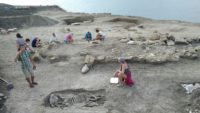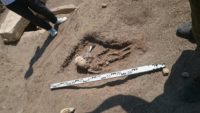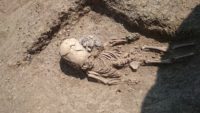 Archaeologists and student volunteers have discovered the skeletal remains of a young child with an artificially deformed cranium in a necropolis on the Kerch peninsula in eastern Crimea. The team from the Institute of Archeology of the Russian Academy of Sciences and the Archeology Foundation have been excavating the ancient necropolis of Kyz-Aul for three weeks. Several graves dating from the 1st century B.C. to the 3rd century A.D. have already been unearthed during this field season. They’ve found the remains of Sarmatian soldiers in monumental stone crypts and horse burials, but the child’s grave is the only one to feature the elongated skull characteristic of intentional cranial deformation.
Archaeologists and student volunteers have discovered the skeletal remains of a young child with an artificially deformed cranium in a necropolis on the Kerch peninsula in eastern Crimea. The team from the Institute of Archeology of the Russian Academy of Sciences and the Archeology Foundation have been excavating the ancient necropolis of Kyz-Aul for three weeks. Several graves dating from the 1st century B.C. to the 3rd century A.D. have already been unearthed during this field season. They’ve found the remains of Sarmatian soldiers in monumental stone crypts and horse burials, but the child’s grave is the only one to feature the elongated skull characteristic of intentional cranial deformation.
Researchers have confirmed from osteological analysis that the remains are those of a boy. Because his fontanelle was not fully closed, scientists were able to determine that he was around 18 months old at time of death. His remains were radiocarbon dated to the 2nd century A.D. when the peninsula was part of the Bosporan Kingdom, a Hellenistic kingdom that became a client state of the Roman Empire in 1st century. The bones are in an excellent state of preservation. Buried with the child were a clay vessel near his head and a few small beads of colored glass. The boy was wearing a copper alloy bracelet on his right wrist. He was interred directly in the ground. No remains of a coffin, gravestone or marker were found.
 The excavation team nicknamed this find “the grave of an alien” because of the skull shape, an unfortunate phrase that all of the articles in the press have glommed onto even though intentional cranial deformation has been an entirely terrestrial human phenomenon for thousands of years. Examples of it have been found in every inhabited continent, and the inhabitants of the Black Sea coast, most notably the Sarmatians, had been altering their children’s’ skull shapes for centuries by the time this little boy was born.
The excavation team nicknamed this find “the grave of an alien” because of the skull shape, an unfortunate phrase that all of the articles in the press have glommed onto even though intentional cranial deformation has been an entirely terrestrial human phenomenon for thousands of years. Examples of it have been found in every inhabited continent, and the inhabitants of the Black Sea coast, most notably the Sarmatians, had been altering their children’s’ skull shapes for centuries by the time this little boy was born.
The cranial modification process began in infancy when the bones of the skull are malleable. In the Black Sea region, people wrapped plaits around babies’ heads and over time the pressure of the wrapping changed the shape of the skull. The elongated egg shape was considered more aesthetically pleasing than the regular old boring skulls they were born with, and had important cultural and social significance because it was an attribute of the Sarmatian military nobility who were increasingly powerful in the Bosporan Kingdom. It was primarily boys destined to be elite fighters who had their skulls modified, so it’s likely this child was slated to be a Sarmatian warrior.
 The date of the child burial is a meaningful one within this context because the Sarmatian warrior elite, who mainly fought as heavy cavalry for the Bosporan Kingdom, had grown in power and influence to such a degree that by the 2nd century A.D., the formerly Hellenistic kingdom was increasingly Sarmatized. It was in the 2nd century that the last of the Greek ruling dynasties died out and was replaced by a new Sarmatian dynasty. This takeover had far-reaching cultural implications. Artisan crafts were decorated with Sarmatian motifs instead of Greek ones. Even the way people dressed changed, with trousers and long-sleeved shirts replacing the Greek tunics and gowns.
The date of the child burial is a meaningful one within this context because the Sarmatian warrior elite, who mainly fought as heavy cavalry for the Bosporan Kingdom, had grown in power and influence to such a degree that by the 2nd century A.D., the formerly Hellenistic kingdom was increasingly Sarmatized. It was in the 2nd century that the last of the Greek ruling dynasties died out and was replaced by a new Sarmatian dynasty. This takeover had far-reaching cultural implications. Artisan crafts were decorated with Sarmatian motifs instead of Greek ones. Even the way people dressed changed, with trousers and long-sleeved shirts replacing the Greek tunics and gowns.
At the same time, Sarmatians made peace with the Romans, who had been fighting them since the 1st century B.C., and in 175 A.D. negotiated a treaty with Emperor Marcus Aurelius. By the terms of the treaty, the Sarmatians agreed to send Rome 8,000 of their famed heavy cavalry. More than half of them were sent very far from home to guard Hadrian’s Wall. Sarmatian artifacts — weapons, beads — have been found at the wall, and there are surviving documents that record Sarmatian squadrons manning several of the forts.
“They’ve found the remains of Sarmatian soldiers in monumental stone crypts and horse burials,…
It was primarily boys destined to be elite fighters who had their skulls modified, so it’s likely this child was slated to be a Sarmatian warrior.”
Did the article mention if any of the skulls of the Sarmatian warriors were elongated?
Thank you for the excellent article, as always :yes:
мыс (Cape) Кыз-Аул, at [36° 22′ 28,6″E, 45° 03′ 35,1″N], now allegedly in the Autonomous Republic of Crimea ? independent of any current pinheads around the ravaged Black Sea, some alien ‘Hunnic’ traditions seem to have survived until pretty much recently, e.g. in places like Southern France. Besides, even Old Herodotus already mentions “Skyths” and “Sa(u)r(o)matians”, but each term seems to describe a whole set of different (migrating) tribes, and only some of them seem to have had modified skulls.
Moreover, Sarmatians were also present in the Roman military camp of Gelduba / Krefeld at the ‘Limes Germanicus’, and In late antiquity, some of their tribes played a role during the migration period. Iranian heavy cavalry, which also is referred to as cataphracts (καταφράκτης = “protected”) could be interpreted as a form of early prototype for Medieval “Chevalry”.
“At the same time, Sarmatians made peace with the Romans, who had been fighting them since the 1st century B.C., and in 175 A.D. negotiated a treaty with Emperor Marcus Aurelius. By the terms of the treaty, the Sarmatians agreed to send Rome 8,000 of their famed heavy cavalry.”
Marcus Aurelius concluded that treaty with the Iazyges, a Sarmatian tribe which had settled in what is now trans-Danubian Hungary – a long way from the Bosphoran kingdom.
No doubt pseudoscientific ancient astronaut theorists will argue to point. If there is a DNA test showing that the child is human, the AA believers will then shout coverup.
I’m trying to picture what a group of Sarmatian warriors would look like coming toward me in battle array. With their altered skulls they must have looked fearsome…
“More than half of them were sent very far from home to guard Hadrian’s Walll”: oh well, I’m a Sarmatian as well as a Viking.
“I’m trying to picture what a group of Sarmatian warriors would look like coming toward me in battle array”: probably rather like a pack of rugby forwards from (say) Langholm, with their scrum caps playing the role of deformed skulls. But the absence of horses would be noticeable.
Has soil analysis been done to ensure, positively, this unfortunate creature did not emigrate from Area 51??
Were these people the ‘macrocephali’ mentioned by Hippocrates?
Here, the idea originally might have been to make ones own scalp and skullcap less attractive 👿
——————–
Histories IV, 64: (in 65, Herodotus describes Skyth and Sauromatian skullcaps being turned into drinking cups)
“That which relates to war is this: When a Scythian has slain his first man, he drinks some of his blood: and of all those whom he slays in the battle he bears the heads to the king; for if he has brought a head he shares in the spoil which they have taken, but otherwise not [cf. Samurai warriors in late medieval Japan]. He takes off the skin of the head by cutting it round about the ears and then taking hold of the scalp and shaking it off; afterwards he scrapes off the flesh with the rib of an ox, and works the skin about with his hands; and when he has thus tempered it, he keeps it as a napkin to wipe the hands upon, and hangs it from the bridle of the horse on which he himself rides, and takes pride in it; for whosoever has the greatest number of skins to wipe the hands upon, he is judged to be the bravest man. Many also make cloaks to wear of the skins stripped off, sewing them together like shepherds’ cloaks of skins; and many take the skin together with the finger-nails off the right hands of their enemies when they are dead, and make them into covers for their quivers: now human skin it seems is both thick and glossy in appearance, more brilliantly white than any other skin. Many also take the skins off the whole bodies of men and stretch them on pieces of wood and carry them about on their horses.”
IV. 64: 1 Τὰ δ᾽ ἐς πόλεμον ἔχοντα ὧδέ σφι διακέαται· ἐπεὰν τὸν πρῶτον ἄνδρα καταβάλῃ ἀνὴρ Σκύθης, τοῦ αἵματος ἐμπίνει, ὅσους δ᾽ ἂν φονεύσῃ ἐν τῇ μάχῃ, τούτων τὰς κεφαλὰς ἀποφέρει τῷ βασιλέι. ἀπενείκας μὲν γὰρ κεφαλὴν τῆς ληίης μεταλαμβάνει τὴν ἂν λάβωσι, μὴ ἐνείκας δὲ οὔ. 2 ἀποδείρει δὲ αὐτὴν τρόπῳ τοιῷδε· περιταμὼν κύκλῳ περὶ τὰ ὦτα καὶ λαβόμενος τῆς κεφαλῆς ἐκσείει, μετὰ δὲ σαρκίσας βοὸς πλευρῇ δέψει τῇσι χερσί, ὀργάσας δὲ αὐτὸ ἅτε χειρόμακτρον ἔκτηται, ἐκ δὲ τῶν χαλινῶν τοῦ ἵππου τὸν αὐτὸς ἐλαύνει, ἐκ τούτου ἐξάπτει καὶ ἀγάλλεται· ὃς γὰρ ἂν πλεῖστα δέρματα χειρόμακτρα ἔχῃ, ἀνὴρ ἄριστος οὗτος κέκριται. 3 πολλοὶ δὲ αὐτῶν ἐκ τῶν ἀποδερμάτων καὶ χλαίνας ἐπείνυσθαι ποιεῦσι, συῤῥάπτοντες κατά περ βαίτας. πολλοὶ δὲ ἀνδρῶν ἐχθρῶν τὰς δεξιὰς χεῖρας νεκρῶν ἐόντων ἀποδείραντες αὐτοῖσι ὄνυξι καλύπτρας τῶν φαρετρέων ποιεῦνται. δέρμα δὲ ἀνθρώπου καὶ παχὺ καὶ λαμπρὸν ἦν ἄρα, σχεδὸν δερμάτων πάντων λαμπρότατον λευκότητι. 4 πολλοὶ δὲ καὶ ὅλους ἄνδρας ἐκδείραντες καὶ διατείναντες ἐπὶ ξύλων ἐπ᾽ ἵππων περιφέρουσι.